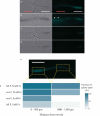Iron availability modulates the Arabidopsis thaliana root calcium signature evoked by exogenous ATP
- PMID: 31304865
- PMCID: PMC6768249
- DOI: 10.1080/15592324.2019.1640563
Iron availability modulates the Arabidopsis thaliana root calcium signature evoked by exogenous ATP
Abstract
Plants use changes in cytosolic free Ca2+ ("signatures") to encode information from the specific signals generated in development, immunity and stress perception. Phosphate availability has a significant impact on the Arabidopsis thaliana root calcium signatures generated in response to abiotic stress stimuli and exogenous purine nucleotides. In the case of the response to exogenous ATP, the effect of low phosphate availability is linked to abnormal iron and reactive oxygen species accumulation with iron deprivation's restoring normal signature dynamics. Here, the effect of iron deprivation with normal phosphate availability has been examined. Iron deprivation significantly alters the root calcium signature evoked by exogenous ATP and may link to levels of reactive oxygen species and callose deposition.
Keywords: ATP; calcium; callose; iron; phosphate; reactive oxygen species; wave.
Figures


References
Publication types
MeSH terms
Substances
Grants and funding
LinkOut - more resources
Full Text Sources
Medical
Miscellaneous
